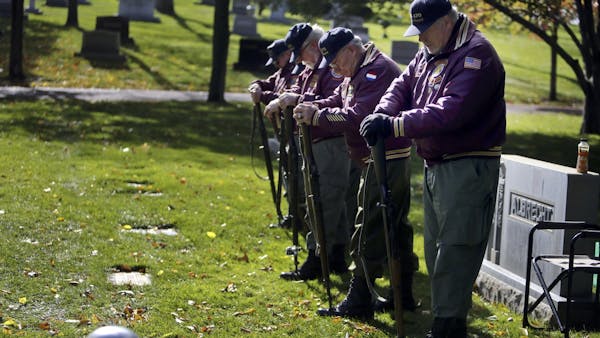In the end, rank falls away.
Across the acreage of a national cemetery, identical headstones stand in mesmerizing formation. Placed with the precision that defines military service, whether in the angle of a hat or the corner of a bedsheet, the markers create their own geometry. From any angle, they resemble a taut line of soldiers hearing their first "Ten-hut!" echo across camp.
As service to country began, so its legacy ends.
At Fort Snelling National Cemetery in the Twin Cities, more than 180,000 veterans and family members lie in a landscape whose consistent simplicity sets it apart from private cemeteries with more personalized gravestones.
Its appearance follows the view of noted landscape architect Frederick Law Olmsted (he designed Central Park) that national cemeteries ought to be "studiously simple," with the main goal "to establish permanent dignity and tranquility … a sacred grove."
"It's an orderly way of doing things, but then anything with the military is very orderly," said Joe Sporko, managing principal of the LA Group, a firm in Saratoga Springs, N.Y., known for designing national cemeteries.
One goal is efficiency: "With the grid pattern, it's easier to locate graves," he said. "But they also wanted that universal look, that equality, so no one soldier buried there is favored."
Donn Christy began working years ago at Fort Snelling National Cemetery as a janitor. Now he's assistant director. He can't say enough about the caretakers, most of them veterans, who keep the grass trimmed to crewcut precision among the marble grave markers, each 42 inches long, 13 inches wide and 4 inches thick.
"We only have one chance to get it right for a family," Christy said. "You really serve to make that day for them, make it as painless as possible."
When his own father was buried in 2008, there were 22 funerals scheduled on the grounds, "but it felt like ours was the only funeral that day."
The need has not yet ended
National cemeteries date back to the Civil War when President Abraham Lincoln, facing rising casualties, oversaw the first purchase of formal burial grounds at Arlington, Va. Until then, soldiers and officers usually were buried where they fell.
But the numbers, the sheer numbers, forced the issue. That, and the nature of the conflict: Congress said that those who volunteered to keep the Union intact deserved special final resting places. (Not until 1901, when a spirit of national reconciliation took hold, were Confederate soldiers allowed to be re-interred in a special section in Arlington National Cemetery.)
From the beginning, the goal of bringing together those who had died during active duty was daunting. "Staff spent four years walking nearly every inch of ground at major and minor battlefield sites, hospital and prison sites, entrenchment sites, along lines of march, and miles of shoreline in search of bodies," according to a history provided by the National Cemetery Administration.
In 1873, regulations were amended to allow any honorably discharged soldier, sailor or Marine to be buried in a national cemetery, even if they had not died in battle. That spurred establishment of more cemeteries, stretching beyond Civil War battlefields to Nebraska, New Mexico and California.
Fort Snelling was founded in 1939. It's now among the 20 busiest national cemeteries, serving the Upper Midwest.
The need for cemeteries continues, with 131 national cemeteries now providing a resting place for more than 3.7 million veterans, their spouses and dependents, and members of certain specified groups, such as Merchant Mariners who served in World War II.
A need for solemnity
The distinctive geometry of a national cemetery probably isn't for everyone. Many veterans choose to be buried in family plots, beneath headstones that may reflect more personality, or a family's sentiments.
In 1997, the Department of Veterans Affairs adopted the Inclusive Inscription Policy, which allowed for an additional inscription on the marker, within space limits. Walking through the newer sections of Fort Snelling, a visitor might see:
"He made a difference."
"He always took the scenic route."
"Smart, funny and loved."
"Joined the Navy, saw the world."
"A kind and good soft-spoken man."
"A real character."
"Saddle up, partner."
"Never had it so good."
For a time in the 1970s and 1980s, some cemeteries began using markers that were flush to the ground. While easier for caretakers to tend, the intent also was to create more of a bucolic, parklike atmosphere, according to a book of essays, "Places of Commemoration: Search for Identity and Landscape Design."
But people missed the gravity of the ranks of markers, noting that they weren't visiting a park, but a cemetery.
"The flat markers didn't have the same look," said Sporko, the cemetery designer. "It looked more like an open field.
"You don't get that sense of …" He paused, recognizing that certain things can't be described, but must be witnessed to be felt. "It's quite a sight."
Kim Ode • 612-673-7185
Salman Rushdie's 'Knife' is unflinching about his brutal stabbing and uncanny in its vital spirit
ABBA, Blondie, and the Notorious B.I.G. enter the National Recording Registry

